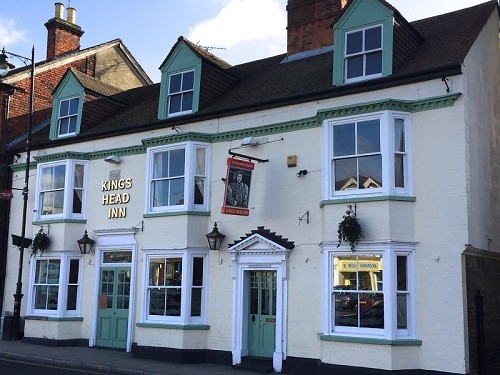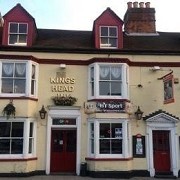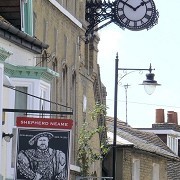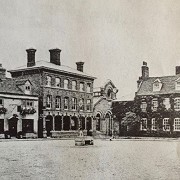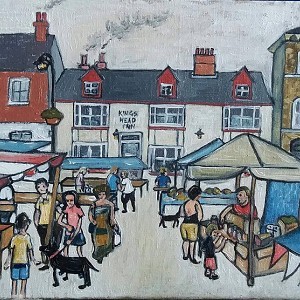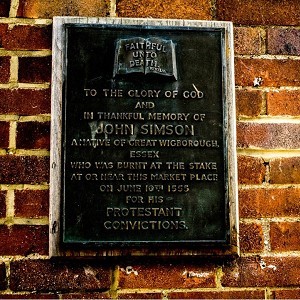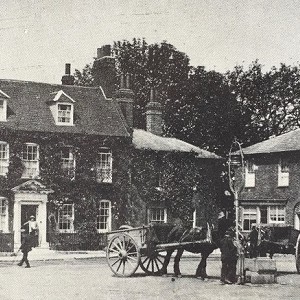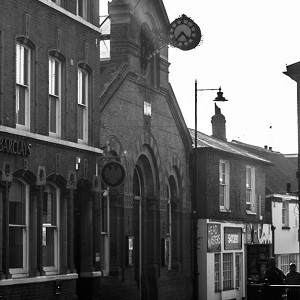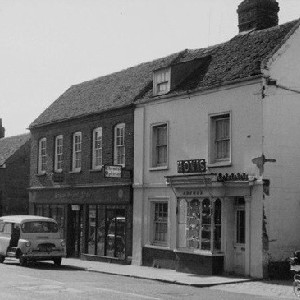History of King's Head (HT)
The King’s Head is a Grade II Listed Building. It is L-shaped in plan with two extensions at the rear around what may have once been a courtyard. It is two storeys high and has an attic. The present building is believed to date from about 1739, but the rear extensions may date back to the 17th century. The front facade of the building dates from the 18th or 19th century. It was not unusual for buildings to have new fronts put on them as fashion changed and this was cheaper than rebuilding the whole structure. Maybe the façade was added when the name was changed from the Blue Boar to the King’s Head in 1793. There is also speculation that the building front used to be on Back Lane and was ‘refocused’ once Market Square became the focal point.
It is built of yellow stocks with Flemish bond, which is where each row of bricks has alternate headers (the end of the brick) and stretchers (the side of the brick) along it. This style was popular in the late 18th and early 19th centuries which also matches the date of the name change and helps to date the façade. The bricks have been painted white at the front.
The King’s Head has a red plain tiled roof with a large red brick chimney stack to right. There are three gabled dormers in the roof giving light to the attic rooms. The ground and first floors have three bay windows with sashes. A dentil band above the first floor continues across the front. The second floor has three flat sash windows. There are doorways to the left and right of the central bay window. The left-hand door has a moulded surround, a rectangular fanlight and a shaped cornice head. The right-hand door has a moulded surround, and a moulded dentilled pediment.
In England there were three types of hostelries which by the 16th century had become recognised in law. Alehouses provided basic food and may have offered cheap accommodation. They were establishments for the lower classes. Next up the ranks of hostelries were taverns. These were like modern restaurants providing good quality food and drink. Inns were the top rank establishments and were the equivalent of modern hotels.
The King’s Head was an inn. Rochford was on the main coaching route to London. Coaches with steel springs giving a more comfortable ride were introduced in the 1750s along with better breeds of horses which were sturdier and ate less. Some of the coaches came from Prittlewell, but many started at the King’s Head. The coach would do the route in stages, each one ending at an inn where the horses were changed and passengers could get on or off, hence the term stage coach. There was more than one operator and the journey took about five hours with coaches running two or three times a week. By 1847 the railway had reached Brentwood so some coaches from Rochford just went there. They were discontinued in 1889 when the railway reached Rochford.
The Essex hunt met outside the King’s Head each autumn. At the rear is the site of the King’s Head stables in Back Lane. A fur and feather sale used to be held here on market days. It was an auction of rabbits, chickens, geese, ducks and the odd goat.
After many centuries as a public house, the King’s Head closed its doors for the last time in 2017. It is now expected to be repurposed as flats, so at least Rochford will keep this historic building.

